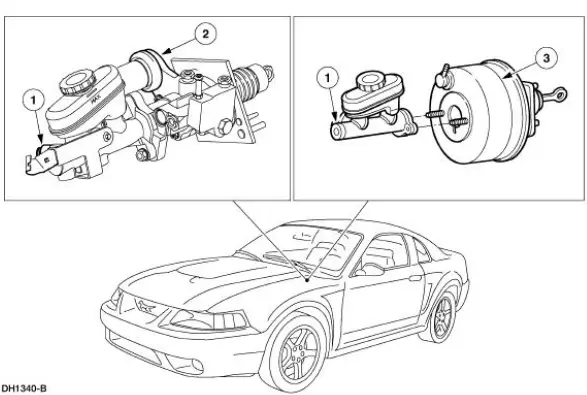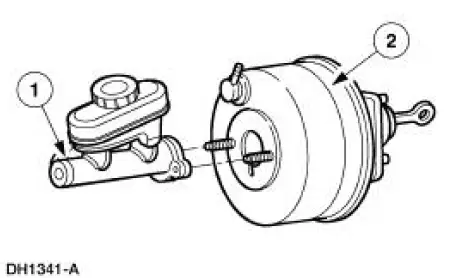Ford Mustang (1999-2004) Service Manual: Brake Booster - Vacuum (Description and Operation)
Power Brake Booster


The vacuum type power brake booster (2005):
- is a dual diaphragm, vacuum assisted power brake booster
- reduces brake pedal force and travel distance.
- is located on the LH side of the bulkhead in the engine compartment, between the brake pedal (2455) and the brake master cylinder (2140).
- is divided into separate chambers by the diaphragms.
- will not operate if vacuum is restricted or if any of the vacuum related power brake components fail.
- is installed as an assembly.
If the power assist fails, the brake system will continue to operate with increased brake pedal effort.
Hose and Check Valve
The power brake booster check valve (2365):
- is located on the front of the power brake booster.
- is installed separately; (install a new grommet when installing a new check valve).
- is positioned between the power brake booster and the power brake booster hose.
- closes when the engine is turned off.
- in the closed position, traps engine vacuum in the power brake booster
- retains vacuum to provide several power assisted brake applications with the engine off.


 Power Brake Actuation
Power Brake Actuation
Torque Specifications
...
 Brake Booster - Hydro-Boost (Description and Operation)
Brake Booster - Hydro-Boost (Description and Operation)
The Hydro-Boost brake booster is a hydraulically operated brake booster
powered by the power
steering pump (3A674). The power steering pump provides the fluid pressure to
operate both the
power brak ...
Other materials:
Oil Pump Screen and Pickup Tube
Removal and Installation
1. Remove the oil pan (6675). For additional information, refer to Oil
Pan in this section.
2. Remove the oil pump screen cover and tube (6622) and discard the gasket.
1. Remove the nut.
2. Remove the two bolts.
3. Remov ...
Anti-Lock Control - Traction Control
Torque Specifications
Anti-Lock Control -Traction Control
The four wheel anti-lock brake system (4WABS) with traction control consists
of the following
components:
anti-lock brake control module (2C346)
front anti-lock brake sensor (2C204)/(2C205)
front ...
Bulb - Headlamp
Removal
WARNING: The halogen bulb contains gas under pressure. The bulb may
shatter if the
glass envelope is scratched or if the bulb is dropped. Handle the bulb only
by its base. Grasp
the bulb only by its base. Avoid touching the glass envelope.
NOT ...
